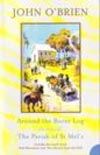
AROUND THE BOREE LOG
Australia, 1925, 70 minutes, Black and white.
Directed by Phil Walsh.
Around the Boree Log is a silent film version of some of the famous poems by Monsignor Hartigan, 'John O' Brien'. The poems have become part of the Australian Catholic heritage with their picture of the country town, the Catholics in the country, the school and sacramental life of the church. They are part of the Australian heritage of ballads.
This film was made in the mid-'20s. There was some comment at a Royal Commission that it was somewhat sectarian in its picture of Catholicism - but film distributors argued that it wasn't. In retrospect, it definitely looks quite triumphalist in its picture of the Irish Catholic church in Australia. There is the portrait of the family - and life in the bush with its serious side and humour. There is the parish priest, beloved of the parishioners. There is the visit of the Bishop.
The black and white photography is quite effective, especially with its fixed camera. The captions are a good opportunity for putting the text of John O' Brien's poems - however, many of them, like 'Said Hanrahan', are quoted only briefly.
The finale of the film shows the transition from the 1880s and the bush school and church to the modern cathedral and school of Goulburn NSW.
1. An interesting and entertaining film of the '20s? The style of the silent films, black and white photography, fixed camera, action within the frame? The quality of the black and white photography? The nature of the acting - stylised over-acting?
2. The editing and pace, the use of the captions for the poems, the visual rhythms of the action? The rhythmical imagery matching musical style?
3. John O' Brien and his poems, their reputation, popular ballads, ballad style? Humour, sentiment? A fierce patriotic Australianism? Loyalty to the Catholic church and its sacraments and devotions? The Irish Catholic family? School? Church?
4. The central role of the parish priest, his image? Reading the poems in a visual chorus? Father Pat and his presence, dress, manner, always around? Currajong running away? Helping in the rescue? The Bishop - and his friendliness, the visit and the questions for Confirmation? The humour of Tangmalangaloo? Father Pat and the tribute of the convent, school and church building?
5. The image of the Catholic Church in New South Wales, 1880-1925? The transition from bush school and church to the city of Goulburn, the cathedral, the high school, the children? A church triumphant and confident in itself?
6. The use of the verse: the words, the characters described, the scenery, dramatising incidents?
7. The Caseys: mother,(at home, working, the accidents), the hawker and buying things - but not enough money? Anxious about Jim? The build-up to the marriage? A devout family? Laughing Mary, at home, school, swapping dinners, flirting, growing up, the socials, the proposal, her saying yes, the wedding? Continuing the tradition? The other children, the boys, buying: of the hats, playing, fights, school, the boy buying the doll for his little sister? The bonds in the Catholic family?
8. School: the teacher, the bell, the raucous children, playing, their clothes? The visit of the Bishop, singing, the boy from Tangmalangaloo?
9. Social life in the bush: the races, the high jumps, parish group, the dog and the presbytery? Norah O'Neil?
10. The drama with Jim lost and rescued?
11. The bush way of life, simplicity, patriotic, in the new land? The significance of religion?